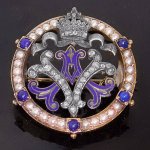Nous offrons des facilités de paiement pour le bijou de vos rêves. Demandez nous les détails. Expédition assuré gratuite !

Antique jewelry glossary
Welcome to our extensive antique jewelry glossary with around 1,500 jewelry related entries.If you feel you are missing an explanation, feel free to let us know and we will add it.
A - B - C - D - E - F - G - H - I - J - K - L - M - N - O - P - Q - R - S - T - U - V - W - X - Y - Z all
Lapis Lazuli

See our: Lapis lazuli jewelry.
A gemstone that is massive, typically of a deep blue color, but sometimes with mottlings of white. It is a complex mineral, composed of grains of several blue minerals, including hacyne, lazurite, and sodalite, in a matrix of calcite, and sometimes spangled with inclusions of brassy-coloured pyrites. The varying proportions of the minerals determine the color of the stone.
As it is opaque, it is cut en cabochon or flat, and never faceted; it has a poor luster and is dull except when it is given a polished surface. it has been used since ancient times (known then as sapphire'). In some Anglo-Saxon jewelry the inlaid decoration, once thought to be lapis lazuli, is now considered to be blue glass. It has been made synthetically, and has been used to produce ultramarine, a coloring pigment now also made synthetically.
The stone has been imitated by Swiss lapis (blue-dyed jasper), by dyed agate, by sintered synthetic spinel, and also by paste, blue enamel, and ceramic ware, all of which are readily distinguishable. Some lapis has been stained to make it darker.
From: An Illustrated Dictionary of Jewelry, autor: Harold Newman, publishers: Thames and Hudson









